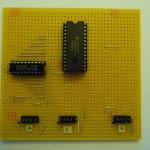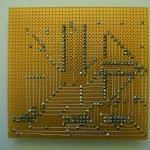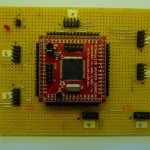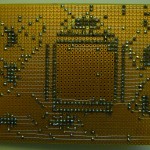Just before writing my last post, I started building another board in order to supply my ATmega128 with 64Kbytes of external memory (in fact the so called “XMEM” feature was one of the reasons I bought that chip).
The board is designed for a 28 pin S-RAM IC (Hitachi HM6264) that can be connected to a micro controller supporting external memory (like the ATmega128 or ATmega162) using three 10 pin headers. The first header is used for the multiplexed lower address/IO bits (port A on micro controller), the second for dedicated upper address bits (port C) and the last for read/write strobe and address latch enable (port G). All headers share two common last pins: GND (9) and VCC (10). The only thing required except for the S-RAM itself, some pin headers and a 100uF ceramic capacitor is a octal latch IC (74AHC573) that will allow for multiplexing the shared lower address/IO lines.
NOTE
After looking up the “Address Latch Requirements” section in the ATmega128 datasheet turns out that when the micro controller is operated above 8MHz (mine has a 16MHz crystal) the 74HC573 (the IC I have) does not meet requirements but a 74AHC573 would do. I guess I will put in a 8MHz crystal until I can get hold of a 74AHC573.
Download




